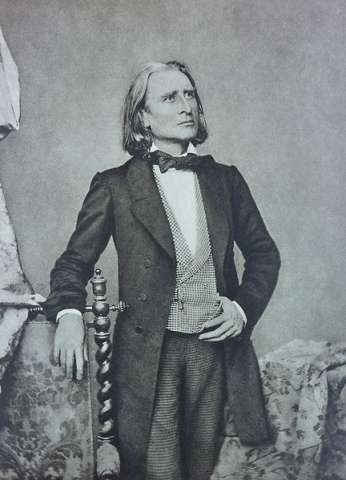
For most of us, the name of Franz Liszt conjures up a two word phrase: piano virtuoso. Liszt gave us the piano recital: before him, no pianist was so sure of his prowess and showmanship as to dare to book a large concert hall and pull in an adoring audience there to see just one man playing the piano for an entire evening.
Liszt’s vast array of piano pieces abounds with showmanship: whether or not they are more difficult to play than other composers’ works, they sound more difficult and more impressive. But amidst all the razzmatazz, it’s easy to overlook the depth, variety, innovation and sheer quality of the music. His masterwork, the single movement Sonata in B Minor, builds a series of themes into a massive musical structure with a coherence that would later be echoed in the operas of his son-in-law Richard Wagner. The shorter Totentanz is utterly convincing in its depiction of a series of shifting moods, while the Hungarian Rhapsodies alternate joyous fireworks with moments of rare delicacy. Equally impressive are Liszt’s transcriptions and “reminiscences”. Listening to his Reminiscences de Norma gives you the uncanny feeling that you’re listening to the original Bellini opera, while being aware that this can’t possibly be right since there’s only one man and a piano. Liszt formed part of the democratisation of music to wider audiences, playing music by many other composers and transcribing Beethoven’s nine symphonies for the piano.
Liszt’s output stretched far beyond piano works, including wonderful religious music and orchestral works, notably the Faust Symphony and a series of symphonic poems.
Liszt was born in 1811 to a musical German-speaking family in Sopron, in a small finger of Hungary very close to the Austrian border and the Esterhazy Palace in Eisenstadt where Haydn was employed for many years. He was taught by Carl Czerny (the author of the dexterity studies still used by many of today's piano students) and was recognised early as a child prodigy: his one act opera Don Ssanche, ou le château de l’amour, received its première five days before his fourteenth birthday. For the first half of his life, he lived as a travelling musician, touring the major cities of Europe (particularly Paris) and dazzling an ecstatic public. His superstar nature was reflected in a prolific and tempestuous love life; although he had a series of highly public affairs and several children, he never married. In 1847, he gave up public performances to focus on composition and teaching, living first in Weimar and then in Rome. He became a revered and influential teacher: extraordinarily, he did not charge for lessons, believing that he had already made enough money from his music.
For much of the twentieth century, critics belittled Liszt’s music as flashy and superficial: he was seen as the dead end of a decadent romantic movement. More recently, music scholars have been kinder, perceiving compositional techniques which have strongly influenced 20th century music. But throughout this time, his works have been continuously popular with pianists and audiences, and he stands as one of the most memorable composers of the 19th century.
| Año de nacimiento | 1811 |
| Año de muerte | 1886 |
| Nacionalidad | Hungría |
| Periodo | Romántico |




